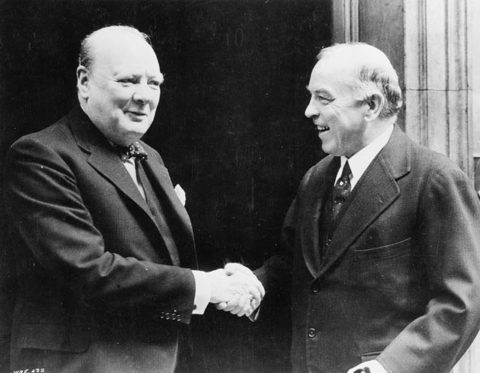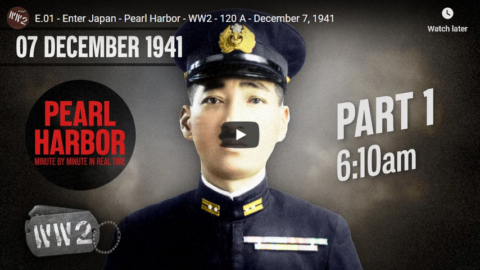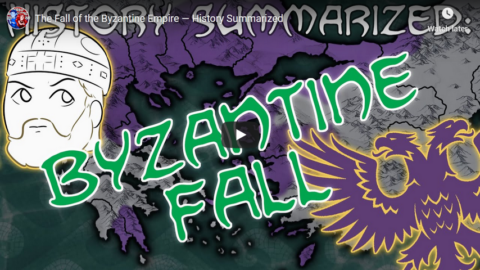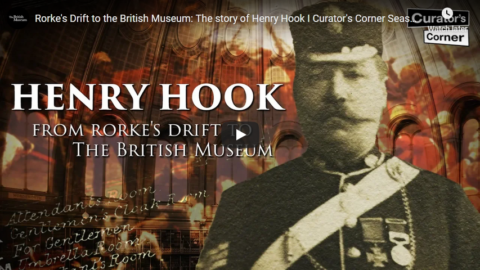Overly Sarcastic Productions
Published 18 Feb 2016Today, Blue discusses recurring themes in history! This one’s the Military Expedition, aka what happens when a powerful military juggernaut gets too big for its britches and starts saying stuff like “too big to fail” unironically.
Blue: If you’re curious about the weird chart/graph thing blue showed during the Napoleon segment, look up Charles Joseph Minard [mentioned here and here], the guy who made it. It’s a really cool chart that shows the size of the army as it traveled across Russia (tan) and back (black). You can see how perilous the journey was based on how narrow the line gets. Graphs are cool.
December 9, 2020
Historical Models Summarized: The Military Expedition
QotD: The rise of bebop
The problem goes back to the early 40s, when a revolution took place in jazz. At a Harlem club named Minton’s, while the swing era was still in full bloom, a group of musicians began experimenting with a new approach to the music. Bandleader Teddy Hill formed a house band with drummer Kenny Clarke, trumpeter Dizzy Gillespie, and pianist Thelonious Monk. During nightly jam sessions others would join them, most notably sax great Charlie Parker, who had gotten his start in the swing bands of Kansas City. Vats of ink have been spilled deciphering the meaning of bebop. If jazz writers are to be believed, it defies easy categorization and requires sets and subsets to understand, but a succinct four-part summary was offered by Neil Tesser in The Playboy Guide to Jazz a couple years ago. First, the beboppers used small, quick combos — most often of trumpet and sax backed by piano, bass, and drums — instead of orchestras. Second, they used more complex chords, exploring “lively, colorful combinations of notes that previous listeners considered too dissonant for jazz.” Third, they often abandoned the melody of a song in order to improvise, relying more heavily on the song’s harmony.
Fourth, beboppers had attitude: “Instead of smooth and hummable melodies designed for dancing, the beboppers created angular tunes with unexpected accents and irregular phrases — and they expected people to listen, rather than jitterbug, to these songs and the solos that followed. The boppers emerged as jazz’s first ‘angry young men.’ They saw themselves as artists first and entertainers second, and they demanded that others respect them and their music accordingly.”
Some of the new jazz was undeniably brilliant, and many of the bebop and hard bop recordings that have been remastered and reissued only seem to acquire more appeal with age. Albums like Parker’s Now’s the Time, Art Blakey and the Jazz Messengers, Dexter Gordon’s Go, Sonny Rollins Vol. 2, and Coltrane’s Blue Train are timeless, bristling with energy, jaw-dropping improvisation, and deep spirituality. But when they cast their spell, they laid complete waste to the pop-jazz tradition. Bebop offered challenges musicians thought they could never get from traditional swing bands, as well as an improvisational ethic that provided an escape from the tough work of writing strong melodies. Some of the players saw this: In 1949 drummer Buddy Rich fired his band because his players “just want to play bop and nothing else. In fact,” Rich added, “I doubt they can play anything else.” Louis Armstrong, whose centennial is being celebrated this year, once referred to bebop as “crazy, mixed-up chords that don’t mean nothing at all.” Before long swing had become a joke. Producer Quincy Jones recalls in the documentary Listen Up that as a young musician he once hid backstage from bebop trumpeter Miles Davis so Miles wouldn’t know he was in the swinging band that had just left the stage.
Suddenly, jazz was Art. Gone were the days when 5,000 people would fill the Savoy Ballroom to lindy hop to the sunny sounds of Ella Fitzgerald or Count Basie. Bebop was impossible to dance to, which was fine with the alienated musicians in Eisenhower’s America. (You can bet this era will be well represented by beatnik [Ken] Burns [in his then-unreleased Jazz documentary TV series].) Even bebop’s own founders weren’t safe from the ideological putsch: when Bird himself made an album of pop standards with a band backed up by a string section, he was labeled a sellout. Then Elvis, to simplify matters greatly, reinvented swing for a new generation, and the Beatles arrived with sacks of great new melodies, and jazz was over as a popular music. Remarkably, beboppers and their fans still blame the drop-off on American racism. Miles once called pop music “white music,” and Kareem Abdul-Jabbar, in a documentary about the Blue Note label, offers that “whites couldn’t appreciate anything that came from black culture.” Yet whites were as responsible as blacks for making stars of Ella, Basie, and other black swing artists. Only two kinds of music were allowed on the radio following the news of FDR’s death: classical and Duke Ellington.
Mark Gauvreau Judge, “Out of Tunes”, Chicago Reader, 2000-08-31.
December 8, 2020
Schmeisser’s MP-18,I – The First True Submachine Gun
Forgotten Weapons
Published 14 Aug 2017When Germany began looking in late 1915 for a new weapon ideally suited for the “last 200 meters” of a combat advance, Hugo Schmeisser’s blowback submachine gun would prove to be the weapon that would set the standard for virtually all submachine guns to come. It was a fully automatic-only weapon with a simple blowback action and a rather slow 400 rpm rate of fire. Although relatively heavy, the only real shortcoming of the MP18,I was its use of 32-round Luger snail drum magazines, which was dictated by the German military. These magazines were unreliable and difficult to load, but they were already in production and were a reasonable logistical answer in a time when material and production shortages were an endemic problem in Germany.
The MP18,I managed to see frontline combat only in the closing few months of World War One (50,000 were initially ordered, 17,677 were produced before the Armistice, and only an estimated 3,000 actually saw frontline combat use). During that time, however, it made a significant impression, easily convincing anyone with an open mind that this new type of weapon would play a major role in future wars.
After the end of the war, the Germany Army was prohibited from using submachine guns, so most of the existing ones (including the example in today’s video) were transferred to police organizations instead.
http://www.patreon.com/ForgottenWeapons
Cool Forgotten Weapons merch! http://shop.bbtv.com/collections/forg…
If you enjoy Forgotten Weapons, check out its sister channel, InRangeTV! http://www.youtube.com/InRangeTVShow
QotD: Booze
I absolutely reject all the arguments of increased insurance liability and potential legal problems created by booze — I have no interest in the blatherings of insurance types and lawyers, because they’ve caused most of our Nanny-related problems anyway. The problems occur not with booze itself, but with the lack of personal restraint. And that’s something which is addressed by people acting like adults, not like children let loose in a candy store with $1,000 to spend.
Here’s part of the booze problem we face Over Here.
American beer is too weak, and American short drinks are served too strong.
The problem with weak beer is not its weakness per se, but the fact that you have to drink quite a bit of it to get a decent buzz — and the problem with drinking in quantity is that it’s really difficult to know when to stop once the old Alcohol Accelerator comes into play. I’d rather have a pint of Boddington’s Ale than four Michelobs (which are about equal in terms of buzz generation). The difference is that the former is, well, a pint; the latter is three pints. That’s a lot of liquid to drink, in a lunch hour, which means you have to drink it fast; whereas the Brit pint can be savored in a leisurely fashion, knowing that the destination will be the same.
Kim du Toit, “Un-Lubricated”, Kim du Toit – Daily Rant, 2005-02-24.
December 7, 2020
E.01 – Enter Japan – Pearl Harbor – WW2 – 120 A – December 7, 1941
World War Two
Published 7 Dec 2020Powered by World of Warships – https://wo.ws/PearlHarbor – Register now to receive an exclusive bonus!
In this episode: Japan’s meticulous planning and preparation made it possible to surprise the Americans at Pearl Harbor. Alert on Oahu is largely nonexistent. It is the deep breath before the plunge.
Join us on Patreon: https://www.patreon.com/TimeGhostHistory
Or join The TimeGhost Army directly at: https://timeghost.tvFollow WW2 day by day on Instagram @ww2_day_by_day – https://www.instagram.com/ww2_day_by_day
Between 2 Wars: https://www.youtube.com/playlist?list…
Source list: http://bit.ly/WW2sourcesHosted by: Indy Neidell
Written by: Spartacus Olsson and Indy Neidell
Directed by: Wieke Kapteijns
Executive Producers: Astrid Deinhard, Indy Neidell, Spartacus Olsson, Bodo Rittenauer
Produced by: Astrid Deinhard and Spartacus Olsson
Co-Producers: Maria Kyhle and Francis van Berkel
Edited by: Iryna Dulka
Set Design by: Astrid Deinhard
Graphic Design by: Mikolaj Uchman
Map Animations by: Daniel Haczyk and Eastory
Assistant Editors: Miki Cackowski, Daniel Weiss, Karolina Dołega
Still Colorizers: Adrien Fillon, Norman Stewart, Jaris Almazani, Daniel Weiss, Mikolaj Uchman, Carlos Ortega Pereira
Research by: Indy Neidell, Spartacus Olsson, Markus Linke, Wieke Kapteijns, Bastian Gaete, Lewis Braithwaite, Tim Smith, Ian Irungu
Sound Design by: Marek Kamiński
Dogfights by: Daniel Weiss, Bastian Gaete, Ian Sowden, Dennis StepanovVoices:
Mitsuo Fuchida – Daniel Grieb
Ada Peggy Olsson – Shani Neidell Beard
Iyōzō Fujita – Emi Celis
James Anderson – Emi Celis
Dorinda Stagner – Zora Johnson
Jack Kelley – Ryan Socash
James McClelland – Spartacus Olsson
Phil Rasmussen – Spartacus Olsson
Dan Wentrcek – Dennis Stepanov
Thompson Izawa – Samir Mechel
Robert Isacksen – Ian Sowden
Joseph K. Taussig Jr. – Tim Smith
James Cory – Ryan TeboFilm colorization by: Ricks Film Restoration
Naval Gameplay by: World of Warships
Archive material provided by: Reuters/ScreenoceanA TimeGhost chronological documentary produced by OnLion Entertainment GmbH.
From the comments:
World War Two
1 hour ago (edited)
When we set out to do this crazy project we thought we wanted to try some really new things. As anyone knows that follows us regularly, our first and foremost goal is remembrance — to shine a light on our past and learn form our ancestors’ mistakes and achievements. We try our best to do that with a dedication to facts and details liberated from partisan, or ideological historiography. For this purpose, the attack on Pearl Harbor serves very well. It is a compact event over only a few hours that is spectacular in its nature, tragic in its effect, gripping in its drama, and has tremendous impact on WW2 on all fronts. It is also an event that is often simplified to the point of misunderstanding, has been woven into national mythology, and given rise to some pretty nutty conspiracy myths. Simply put: the Attack on Pearl Harbor is short enough, exciting enough, and misunderstood enough for us to do a limited series like this.But more than that we also wanted to try some new technical and narrative things. Since we started doing historical documentaries with the Great War in 2014 we have tried to be on the forefront of pioneering new ways of creating historiography for the modern media world. Narratively, we have dedicated ourselves to chronologies, which in historiography is nothing new, but it is new in the world of film documentaries (at least to the level we do it) — so we thought; “heck what if we go down to minute by minute for this” — well we did and it taught us an enormous amount about Pearl Harbor, but also about how we can write. We will get back to that in further comment on the series. As for technology, it truly is technology that enables our work, well any media — for us it is social media, affordable ways to capture film, global virtual remote working spaces, digital research opportunities, digital film archives, and so on.
Two areas we had not been able to venture into was recreation of scenes using computer graphics and colorization of moving images. Using a gaming engine to create animation is also nothing new, but usually very, very expensive because you have to first create the world, the assets and the characters for your recreation. But for Pearl Harbor, World of Warships https://worldofwarships.com and World of Warplanes https://worldofwarplanes.com opened an opportunity to do this on a new scale at a cost that is only a fraction of what it usually costs. Along the way we also got to know Ricks Film Restorations (https://bit.ly/ricksfilmresorations and https://www.youtube.com/user/Rick88888888) who use AI technology to enhance and colorize film footage. While both of these technologies are only at the beginning of their potential, we think the results are spectacular. More than anything it has enabled us to enhance the emotional and visual experience for this series to a level we never reached before. Last but not least it enabled us to use the financial contributions of the TimeGhost Army, and World of Warships to create five hours of content for less than 1/50th — only 2% — of what it would cost to do with traditional means.
creatingstuff
In the Name of the entire TimeGhost Team,
Astrid, Indy, Spartacus, and WiekeEpisode Guide:
This is a 10 episode limited series within our weekly coverage of WW2 — to see the immediate events leading up to this day watch episode 119 from December 5, https://youtu.be/DYUzmBuX-6Y. Some of the events covered briefly as they start on this day, such as the invasions in the West Pacific will be covered in more detail in the coming weeks, especially in episode 120K (the 11th episode this week).coming out on December 12.The playlist to get all these episodes in one go is here: https://bit.ly/Pearl-min-by-min
Churchill and the Bengal Famine of 1943
In The Critic, Zareer Masani debunks a recent book’s claim that British PM Winston Churchill was responsible for the Bengal famine during the Second World War:

Prime Minister Winston Churchill greets Canadian PM William Lyon Mackenzie King, 1941.
Photo from Library and Archives Canada (reference number C-047565) via Wikimedia Commons.
A favourite trope of the current Black Lives Madness and its left-liberal white apologists has been the alleged infamy of Britain’s most cherished hero, Winston Churchill, charged with everything from mere racism to actual genocide. The worst accusation is that of deliberately starving four million Bengalis to death in the famine of 1943.
The famine took place at the height of World War Two, with the Japanese already occupying Burma and invading the British Indian province of Bengal, bombing its capital, Calcutta, and patrolling its coast with submarines.
The famine raged for about six months, from the summer of 1943 until the end of that year, and estimates of its victims range from half a million upwards, depending on whether one includes its indirect and long-term effects. Most famine experts agree that famines can be caused by both nature and human agency, but never by any single individual. So how has a 67-year-old British prime minister in poor health, 5,000 miles away, fighting near-annihilation in a world war, come to be charged with causing such a cataclysmic disaster?
The attempt to lay this at Churchill’s door stems from a sensationalist book by a Bengali-American journalist called Madhusree Mukerjee. As its title, Churchill’s Secret War, indicates, it was a largely conspiracist attempt to pin responsibility on distant Churchill for undoubted mistakes on the ground in Bengal.
The actual evidence shows that Churchill believed, based on the information he had been getting, that there was no food supply shortage in Bengal, but a demand problem caused by local mismanagement of the distribution system. Ironically, his view found unexpected support in a 2010 exchange between Mukerjee and the Nobel Prize-winning economist Amartya Sen, the world’s foremost expert on famine in India.
Commenting in the New York Times, Sen said of Mukerjee, that “she seems satisfied with little information” and that her data came from only two rice research stations, and those in only two out of 27 districts in Bengal. “The analysis I made,” countered Sen, “using data from all districts … indicated that food availability in 1943 (the famine year) was significantly higher than in 1941 (when there was no famine) … There was indeed a substantial shortfall compared with demand, hugely enhanced in a war economy … but that is quite different from a shortfall of supply compared with supply in previous years … Mukerjee seems to miss this crucial distinction, and in her single-minded … attempt to nail down Churchill, she ends up absolving British imperial policy of confusion and callousness.”
USS Pennsylvania and Pearl Harbor
The History Guy: History Deserves to Be Remembered
Published 22 Apr 2019USS Pennsylvania was in dry dock when the attack came at Pearl Harbor. The History Guy remembers part of her history that may have been forgotten.
This episode was originally posted December 7, 2017. It has been updated to correct some errors in the original, and new footage of USS Pennsylvania has been added.
This is original content based on research by The History Guy. Images in the Public Domain are carefully selected and provide illustration. As images of actual events are sometimes not available, images of similar objects and events are used for illustration.
All events are portrayed in historical context and for educational purposes. No images or content are primarily intended to shock and disgust. Those who do not learn from history are doomed to repeat it. Non censuram.
Find The History Guy at:
Patreon: https://www.patreon.com/TheHistoryGuy
The History Guy: History Deserves to Be Remembered is the place to find short snippets of forgotten history from five to fifteen minutes long. If you like history too, this is the channel for you.
Awesome The History Guy merchandise is available at:
https://teespring.com/stores/the-hist…Script by THG
#ushistory #thehistoryguy #usspennsylvania
QotD: American politics as “the playoffs”
Like other Americans, however, many libertarians think of political parties like sports teams. They want their own team to root for and cannot root for the other teams. Voting Libertarian gives them psychological satisfaction, while in the aggregate diminishing their political impact.
Libertarians should stop thinking of parties as teams and think of them instead as the playoffs. In NFL football terms, The Democrats are the AFC and the Republicans the NFC. To get into the Superbowl, you have to survive the season and the playoffs in your respective conference. In effect, Libertarians want to form their own league which no one but themselves is interested in watching. And they assure themselves of never making the playoffs much less the Superbowl.
Randy Barnett, “Parties Are Not Sports Teams — Parties are the Playoffs”, The Volokh Conspiracy, 2005-02-24
December 6, 2020
“As ever, our Liberal friends prefer to be judged by their pure intentions rather than their rather tattered record”
The good folks at The Line suggest that we monsters in the peanut gallery stop hurting poor Little Potato’s feeeeeeeeeelings:
What we can say is that supporters of our current government continue to insist that the prime minister and his cabinet be granted a level of benefit of the doubt that they simply have not earned. Declarations that the Liberals have botched the vaccine rollout are premature, but they are not preposterous. As ever, our Liberal friends prefer to be judged by their pure intentions rather than their rather tattered record. We at The Line have known enough true Grits in our time to believe that this isn’t an act. Liberals really do believe that so long as they mean well, they should be forgiven their failures. Indeed, the failures should be forgiven and forgotten.
And boy, can they get testy when someone declines to do them the courtesy of treating this five of a government like a nine. They’ll shriek about Harper and Ford and Kenney and American-style whatever, they’ll argue in bad faith, they’ll demand an audit of Andrew Scheer’s household expenses, they’ll shut parliament down in the middle of a national emergency to spare the boss from embarrassing questions about his latest ethical flub. In short, they’ll do anything to avoid admitting that this Liberal government has blown more than enough high-profile issues to have forfeited any right to be bummed out when someone dares wonder if they’ll do any better on vaccines.
Over the last five years, the Liberals have failed to hit their own targets on balancing the budget and cleaning up Indigenous water supplies. They failed to hit Harper’s targets on carbon reduction, failed to win a UN seat, failed to deliver promised military procurements, failed on electoral reform, failed to improve our decrepit transparency system, and failed to notice any number of outrageous policies and proposals so long as they were proffered en français, in which case they couldn’t avert their eyes fast enough.
We could go on, but the point is made. And they’ve done it all after daring to talk in their opening days of deliverology, a term that’s now a political punchline thanks to how badly Trudeau and the Gang failed to live up to the hype of their own managerial jargon.
The problem with all this failure is far bigger than the sum of its various sad parts. A government that routinely writes cheques its competence can’t cash may be in a hurry to forgive itself, but not all Canadians are as fond of Justin Trudeau as Justin Trudeau clearly is. A proven track record of failure by the state erodes public confidence in the state, and the sneering contempt Liberals have for anyone who notices the failure doesn’t help. We find it absolutely amazing how many Liberals (rightly!) decry the rise of populism without ever seeming to ponder for a New York minute what role their own manifest mediocrity has played in fuelling it. So we’ll kindly hear no more from the Liberals about the know-nothing idiocy of the woke left and the destructive buffoonery of the nationalist right until they stop doing such a shabby job with the goddamned centre.
Halifax: Canada’s Great War Casualty
Geographics
Published 14 Jul 2020This video is #sponsored by Squarespace.
Credits:
Host – Simon Whistler
Author – Ben Adelman
Producer – Jennifer Da Silva
Executive Producer – Shell HarrisBusiness inquiries to admin@toptenz.net
If you found this video interesting, you might also want to read my article on the Halifax Explosion here.
QotD: Mid-70s TV
What was especially unfortunate (rather insidious really) about this moment was that the broadcast model of television distribution created a situation of artificial scarcity. It was not a proper competitive environment like we enjoy today. It truly was monopolistic, even if the snake did have three heads. Only a few huge corporations could afford the infrastructure for these national networks. Airspace was limited. Thus to make room for the new, the old had to be cast aside. As I happen to love all those new shows CBS introduced, I am glad they were brought into being. But how much better it would have been if the older shows could have been retained at the same time, because I also love those. TV variety, heir to vaudeville, was effectively killed dead by this historical moment, and that’s to be regretted.
[…]
But during the second half of the decade things changed. I have a good sense of when all the good shows started going wrong, but have had a harder time on figuring out why they did. As near as I can tell in most cases, the stars of the shows became too big for their britches. They won awards, they were on the covers of all the magazines, they got huge salary increases, and then they started getting creative control over their shows. I’m still somewhat at a loss as to why the actors’ mass madness took the same form all across the board, this humorless didacticism, the need to be “dramatic.” But it could be simply that there is a very funny elephant in the room. Because when I find myself asking the question, “Is it possible that actors are egotistical? Self-indulgent? Consumed with self-importance? Megalomaniacs?” Well, there’s your answer. Those qualifiers practically form part of the textbook definition of the word “actor”. They want to be taken seriously. And so, across the board, most of the stars of these shows started either transforming their characters into Christ-like saviors, or turning their programs into pulpits.
Also perhaps to a certain extent these new situation comedies attracted a different kind of star. The new breed were not the Buddy Ebsen/Lucille Ball/Jackie Gleason/Red Skelton type vaudeville clowns. Most of the new stars were college educated, had gone to drama school, been in improv and other theatre and sketch troupes, and appeared in lots of legit theatre. They didn’t just know who Shaw and Ibsen were, they had performed in such serious drama. They scorned old school comedy as “corny”; they were much more concerned with what they called “truth”. I remember reading interviews with Alan Alda in which he complained about episodes from the first season of M*A*S*H that had more farcical plots (e.g. “Tuttle” or the one where Frank Burns gets gold fever.) Fans happen to love these episodes; Alda however tends to favor dramatic episodes from the later years, but we’ll return to that.
Trav S.D., “The Insufferables, or Sanctimony in the Seventies: How Hollywood Helped Make Liberalism Unpopular”, Travalanche, 2018-03-12.
December 5, 2020
The Fall of the Byzantine Empire — History Summarized
Overly Sarcastic Productions
Published 4 Dec 2020At long last, the concluding chapter of Roman history! Let’s tie the bow on Byzantine Constantinople as the empire comes to an end, slightly earlier than we might think, but far later than anybody ever could have expected.
SOURCES & Further Reading: Byzantium: The Decline and Fall & A Short History of Byzantium by John Julius Norwich, Osman’s Dream by Finkel, https://www.ancient.eu/Despotate_of_t…
This video was edited by Sophia Ricciardi AKA “Indigo”. https://www.sophiakricci.com/
Our content is intended for teenage audiences and up.
PATREON: https://www.Patreon.com/OSP
PODCAST: https://overlysarcasticpodcast.transi…
DISCORD: https://discord.gg/osp
MERCH LINKS: http://rdbl.co/osp
OUR WEBSITE: https://www.OverlySarcasticProductions.com
Find us on Twitter https://www.Twitter.com/OSPYouTube
Find us on Reddit https://www.Reddit.com/r/OSP/
The “new normal” will, by definition not be “normal”
At Spiked, Brendan O’Neill cries “Down with the New Normal!”

“Covid 19 Masks” by baldeaglebluff is licensed under CC BY-SA 2.0
Few phrases inspire more horror in me than “the new normal”. It is falling from the lips of public-health experts and lockdown-loving commentators everywhere. Forget the “old normal” of going maskless into the streets, or ramming yourself into a crowd of thirsty punters at the bar in a pub, or taking a lover without constantly worrying that he or she might make you ill with his or her breath. Such reckless libertinism was for the old world, apparently, the era BC (Before Covid). We are all now heading into the New Normal, a brave new world of forever social-distancing being built for us by a benevolent bureaucracy that simply wants to protect us from disease.
Everywhere you turn there is talk of the new normal. Out will go bare faces, hand-shaking, hugs and sweaty crowds, and in will come masks, elbow-bumping, and sitting six feet away from everyone else at concerts and shows. Bye bye, mosh pits. Yes, even when the vaccine comes, which is when many of us hoped we would see our freedoms restored, the uber-cautious habits we have developed during the Covid crisis should continue, experts say. Jonathan Van-Tam, England’s deputy chief medical officer, said this week that these “habits”, including face-covering, should continue for “many years”. Better safe than sorry, eh?
Van-Tam isn’t alone. Many experts and commentators are predicting, and even welcoming, a decline in social engagement and physical contact as we head into the new normal. “The Coronavirus killed the handshake and the hug — what will replace them?”, asks Time magazine, blissfully unaware of how mad it sounds. “Hugs, high fives, fist bumps, back pats [and] shoulder squeezes” could all disappear after 2020, Time predicts. And it talked to one of many experts who thinks that’s no bad thing. Dr Mark Sklansky, an American cardiologist, told Time he has always hated hand-shaking. “Hands are warm, they’re wet, and we know that they transmit disease very well”, he said. But where “being anti-handshake was fringe thinking” in the past — !! — it is now increasingly common to be handshakephobic, says the wise doctor. Put your wet, diseased paws away, everyone.
And the new normalists are not letting the imminent rolling-out of the vaccine puncture their dreams of a world without clammy handshakes and other forms of sickness-spreading human contact. People expecting to be “back to normal by spring” are “expecting too much” of the vaccine, said a British microbiologist a couple of weeks ago. Even with a vaccine, “we will not be returning to the old normal”, decrees the Lancet. No, apparently “physical distancing and hand hygiene must continue indefinitely”. Maybe these doom-mongers are keen on physical distancing because they know a lot of people would probably like to give them a clout for their miserabilism?
Rorke’s Drift to the British Museum: The story of Henry Hook I Curator’s Corner Season 4 episode 5
The British Museum
Published 12 Nov 2018Henry Flynn recounts the story of Alfred Henry Hook VC, a private in B Company of the 2nd Battalion, 24th Regiment of Foot who served at the battle of Rorke’s Drift before becoming an employee of the British Museum.
From the comments:
shoutinghorse
1 year ago
When the movie Zulu was premiered in 1964 in London descendants of some of the characters were invited to attend including Henry Hook’s two daughters, (5:53) they were elderly ladies by then and were so horrified at the portrayal of their father as a malingering drunken thief that they walked out in disgust. In real life Hook was an honest soldier and a teetotaller. The producers of the film later issued an a apology to the Hook family.












